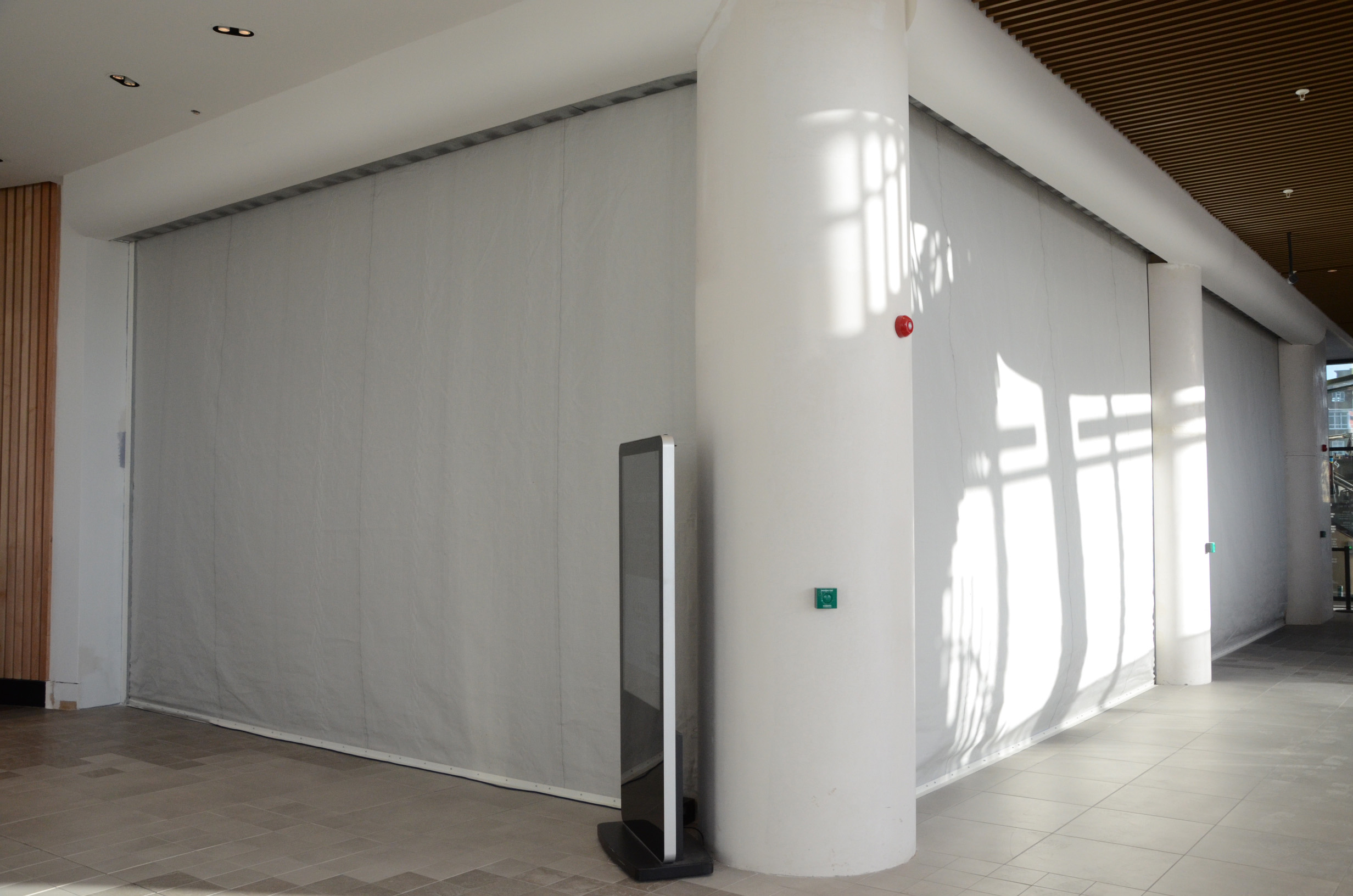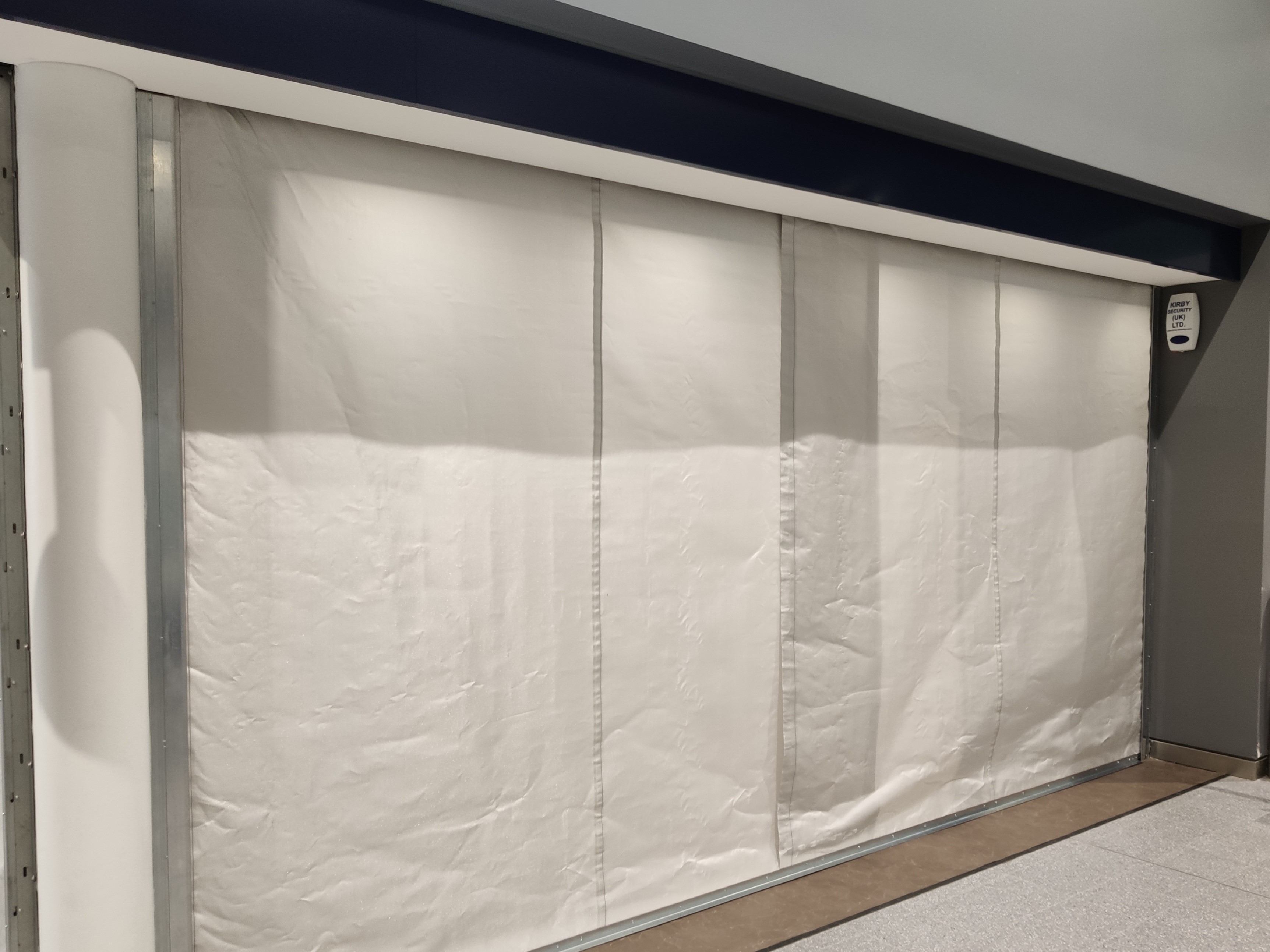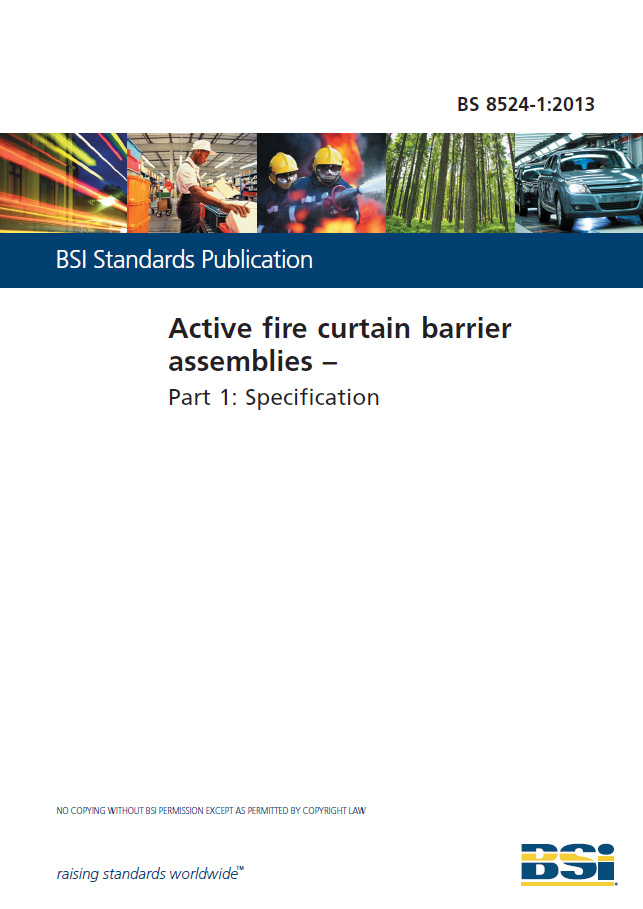Technical Director Ray Kerry explains the important role of standards in ensuring the quality, safety and performance of active fire curtains


Product standards play a key role in ensuring that products of all types meet particular performance, quality and safety standards. They are developed over many years by industry representatives who come together to agree the appropriate requirements and testing procedures. This enables purchasers to understand exactly what performance to expect from a product since it meets the requirements of a specific standard.
Product standards for active fire curtains are no different – they clearly set out performance requirements and put in place tests which put the products through their paces, enabling them to prove their performance. In the UK, there are three main standards which apply to active fire curtains:
BS 8524
The British Standard BS 8524 supersedes and builds on the former fire curtain specification, PAS 121:2007. In addition to laying out stringent testing requirements, it provides a code of practice for the design, installation, commissioning, and servicing of such products. This offers specifiers, fire authorities and authorities having jurisdiction (AHJs) with a high level of confidence in both the product and its installation as a life safety device.
BS 8524-1: Active fire curtain assemblies – Specification, outlines requirements for the design, testing and classification of active fire curtain barrier assemblies. The standard also recognises that the maintenance of fire curtains throughout their lifetime is just as important as the initial specification through BS 8524-2: Active fire curtain barrier assemblies. Code of practice for application, installation and maintenance.
BS 8524 not only tests the product for fire-resistance, but also covers every aspect of the constituent parts that make up the finished assembly; including the fabric curtain materials, the motor drive systems, its frame, and its electrical power and control systems with all associated ancillary devices. It requires a series of operational tests to be undertaken prior to testing on the furnace. These ensure the components all work independently of each other.
BS 8524-1 is a rigorous and complex test standard and is specific only to fire curtain barriers. All of the annexes (A to I) and references must be achieved by the product for it to be fully compliant.
Four of the most critical elements in the annexes are detailed below. These, in combination with the other annexes, provide confidence that the fire curtain will continue to perform as expected for many years after it has been installed.

Annex D (normative) Test method for barrier assembly reliability and response time and the durability of materials
This annex states that the barrier assembly must be tested for its reliability and response time, using the control system with which it is intended to be used to modify its speed. The annex requires the specimen to be tested in the orientation intended by the manufacturer.
The reliability and durability testing simulates usage of the curtain, with the required 500 cycles representing one test each week for 10 years. Importantly, the curtain is cycled prior to the fire test, providing assurance that the fabric still provides a fire barrier, even after years of usage.
Annex D also includes a requirement for the barrier assembly to be tested for impact. This simulates a body colliding or falling into the closed curtain, which is especially important when the curtain is used within a means of escape. A 50kg soft weight is dropped against the face of the curtain (at two different heights) with an impact energy of 100Nm prior to cycling the curtain for 500 operations. At the end of cycling, the curtain is subjected to the impact test again and the curtain is checked for damage.
Annex E (normative) Test method for the durability and reliability of alternative or additional motors
Motor reliability and durability testing provides assurance that the motors fitted to BS 8524 fire curtains will function well beyond the required lifetime of the fire curtain, mitigating as much as possible the risk of motor failure due to general usage
The motor being tested must lift a weight equating to 90% of the maximum load, over a distance of 3m before it is released. A classification is given to the number of cycles attained: C1 for 500 cycles, C2 for 10,000 cycles, C3 for 50,000 cycles.
Annex G (normative) Test method for the reliability of motor operation at elevated temperatures.
This test is carried out by placing a motor specimen in a furnace and operating it at maximum load following a prescribed timeline heat curve for a specified number of cycles. Elevated temperature testing of motors provides evidence that the motor will continue to function during the start of a fire, allowing the fire curtain to be retracted to release anyone trapped or for the Fire and Rescue Service to pass under the curtain.
The other remaining annexes include:
The annexes and test methods are all designed to demonstrate the performance of the product in use and are relevant to its application.
Part 2 of BS 8524 is a code of practice for the design intent, common applications, the installation, commissioning and servicing of the product. There are strict requirements for installation; both the standard and code of practice recommend independent third party approvals, by UKAS-approved laboratories or certification bodies and this is now an industry requirement. Therefore, as part of BS 8524-2, these bodies will regularly audit installations to ensure competency, and that the products installed are as per the certification and the original tests. This is especially important following the recommendations of the Hackitt review of building regulations and fire safety, following the Grenfell fire. Part 2 also recommends a series of regular checks. Some of these can be undertaken as part of regular risk assessments on site, while others must be undertaken by a competent engineer.
BS 8524 advises checking for obstructions that might prevent the curtain from deploying, such as alterations to cosmetic finishes, lighting, shelving, or racking, furniture or temporary displays. It also recommends that the curtain should be operated at least monthly, and on escape routes weekly. If it forms part of a smoke control system protecting a means of escape, the barrier assembly should be operated in conjunction with the smoke control system, at least quarterly.
There should be a test at least monthly of self-closing devices and automatic release mechanisms via a test switch. They should also check that the sensory detection equipment and self-test facility is functioning correctly.
BS 8524 is designed to be a fully ratified and audited product, installation and service scheme. The standard ensures through periodic audits that the provenance of the product’s components is the same as those that were tested originally. Installations are also picked at random for site visits by the approved laboratories or certification bodies to audit for compliance with best practices.

Other standards
ISO 21524 is an international standard for fire curtains which builds on many of the aspects within BS 8524-1 and BS 8524-2. It enhances some of the requirements and introduces new features such as pass doors and vision panels. It also introduces a new requirement to include repair patches to tears in the fabric. The forthcoming new release of BS 8524-1 and BS 8524-2 refers to ISO 21524 for the test method of the new features, and in some cases makes further improvements.
The European Standard BS EN 16034 is one of a series of standards covering windows and pedestrian doorsets, industrial, commercial and garage doors and gates. It covers only fire resisting and/or smoke control characteristics, including the ability to release and self-closing. Further product characteristics are covered in the relevant harmonised European Product Standards EN 14351-1, prEN 14351-2, EN 13241-1 and EN 16361.
As a result, BS EN 16034, unlike BS 8524, is ambiguous in its application to fire curtains. In fact, in its Foreword, BS EN 16034 standard states: “Users’ attention is drawn to the fact that fabric curtains tested in this standard only apply to the fire door sets fire text. This standard does not cover their operation deployment speeds, initiation devices or warning devices, and as such should comply with BS 8524-1 and BS 8524-2.”
To obtain a CE mark, a curtain must comply with the harmonised product standard BS EN 16034. However, this mark can only be applied in combination with either BS EN 14351-1:2006 + A2:2016, which is a standard that relates to windows and doors; or BS EN 13241:2003 + A2:2016, which in turn relates to industrial, commercial, garage doors and gates. Confusion results from the fact that neither of these standards identify Operable Fabric Curtains within their scopes.
As a result of this confusion, the Association for Specialist Fire Protection (ASFP) produced guidance in the form of Technical Guidance Document (TGD) 21: UKCA / CE Marking of Operable Fabric Curtains. This document recommends that manufacturers wishing to CE mark operable fabric curtains seek further independent legal advice on this issue or consult with bodies such as the Construction Products Association (CPA) for further clarification. In addition, it advises that, since BS EN 16034:2014 does not cover the operation deployment speeds, initiation devices or warning devices, for operable fabric curtains, they should comply with BS 8524:2013 Parts 1 and 2. As such, ASFP notes that BS EN 16034:2014 and BS 8524:2013 are complementary standards, and recommends that, where compliance with BS EN 16034:2014 is mandated, this should still be augmented with certification to BS 8524-1 and 2.
Unlike BS 8524, BS EN 16034 does not include tests for reliability and response time of fire curtain assemblies; motor reliability and durability; reliability of motor operation at elevated temperatures; or impact. Similarly, there are no installation or maintainance requirements contained within BS EN 16034.
Why has BS 8524 been embraced by the UK market for fire curtains?
BS 8524 was the first product standard in the world to apply solely to active fire curtain barrier assemblies. It provides assurance to end users that the product has been through, and achieved, a whole series of third party witnessed testing, against a set of discerning criteria, all of which must be met by the product for it to be fully compliant. If one or more tests are not completed then the whole system, including all the individual assemblies and components and the process of manufacture, installing and servicing cannot be signed off as reaching the minimum requirements.
BS 8524 includes tests for safety features critical to securing a safe protected escape, including smoke resistance, gravity fail safe, backup power for retract facilities, fire resistance of motors, ancillary devices, control panels, power supplies, calculation procedure to assess heat resistance, etc. The test configurations are clearly defined in the standard’s annexes. BS 8524 is also the only standard that recognises the importance of correct installation and maintenance of fire curtains throughout their lifetime.
Fire curtains are lifecycle products so, when specifying a system, it is essential to consider the whole package from quality, performance, installation and maintenance. No other standard defines requirements for all of these vital features and tests all the constituent parts of the system.
With this in mind, it is not surprising that those involved in the design or sign-off of a building’s construction – such as architects, fire engineers or building control officers – will use a product-specific standard, like BS 8524, to ensure that the overall quality of the products used within the building are the best possible and meet the highest fire safety standards.
Achieving the highest standard
Ensuring the competence of professionals engaged in specifying or approving fire curtains is vitally important. This can be achieved by following the most stringent and appropriate standards available. BS 8524 was developed specifically for the purposes of providing a dedicated fire curtain standard, covering not just the product but also its effective installation and maintenance, to ensure that the highest standards are achieved.